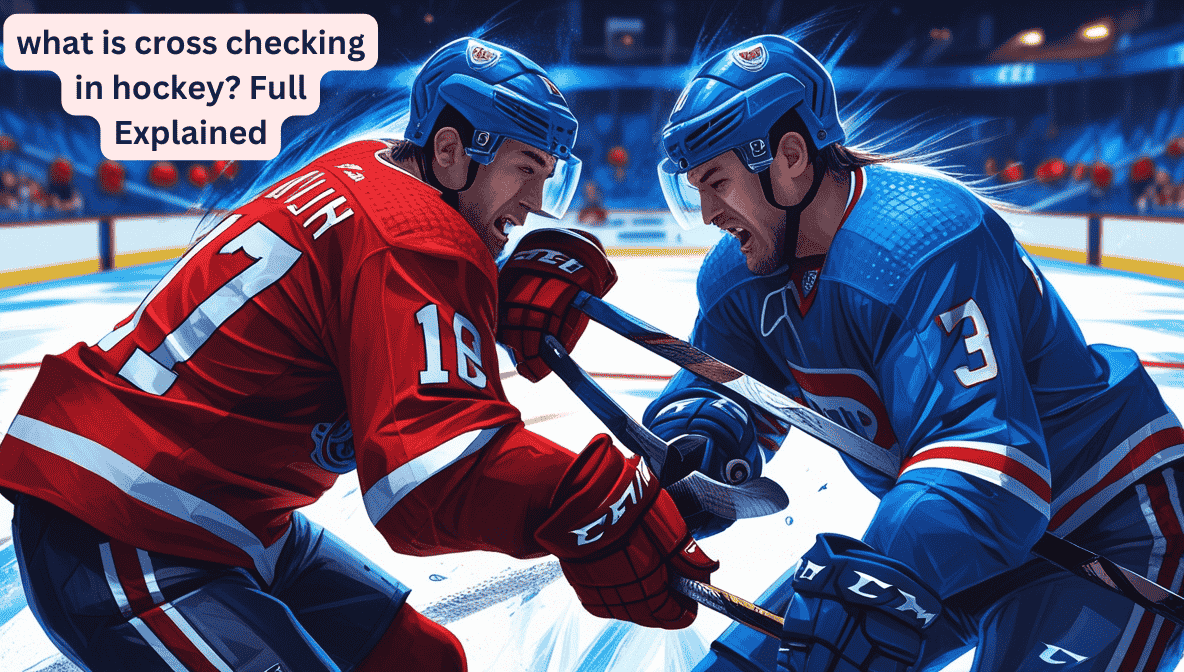Hockey is a famous and favorite sport in the world these days and people who love it have many questions in their mind about hockey.Today’s question is what is cross-checking in hockey? Cross-checking takes place at this point when a player forcefully hits an opponent using both hands on their stick, without keeping the stick on the ice.
what is cross checking in hockey? Full Explained
Cross-checking in hockey is when a player forcefully hits an opponent using both hands on their stick without keeping the stick on the ice. It is considered an illegal move and results in a penalty. This rule is in place to prevent injuries and maintain fair play. Referees call a penalty when they see excessive force used in a cross-check.
Why do players cross-checking in hockey?
Players cross-check in hockey to gain an advantage by knocking opponents off balance or stopping their movement. Sometimes they do it out of frustration or to intimidate the other team. It is often used in physical battles near the goal or along the boards. However, it is illegal and can lead to penalties or suspensions.
Video example of cross checking hockey
What signal does the referee make when there is a cross-checking?

What is the penalty for players who cross check?
Hockey a player who cross-checks an opponent receives a penalty.
- The penalty can be a minor penalty (2 minutes).
- Major penalty (5 minutes) if the hit is severe.
- If the cross-check causes injury the player may also receive a game misconduct or suspension.
Note: Referees decide the penalty based on the severity of the hit.
what is cross checking in NHL hockey?
The same rule applies to NHL hockey. NHL hockey cross-checking is when a player uses both hands on their stick to hit an opponent forcefully. It is an illegal move and results in a penalty. The rule helps prevent dangerous hits and injuries. Referees call a penalty if a player uses excessive force while cross-checking.
How is cross-checking done in lacrosse?
Cross-checking in lacrosse is when a player uses the shaft of their stick, held with both hands, to push or hit an opponent. It is illegal in field lacrosse but allowed in box lacrosse with some restrictions. This rule helps maintain fair play and prevents dangerous contact.
What is hooking in ice Hockey? And why does it happen?
Hooking in ice hockey happens when a player uses their stick to pull or slow down an opponent. It is not allowed and results in a penalty. Players do this to stop the other team from moving forward. This rule helps keep the game fair and safe.
Conclusion
Cross-checking is an illegal move in hockey that happens when a player forcefully uses their stick to hit an opponent. It is not allowed because it can cause injuries and disrupt fair play. Players who cross-check face penalties, which can affect their team’s performance. To avoid this, players should use legal body checks and follow the game’s rules. Fair play makes hockey safer and more enjoyable for everyone.
FAQS
- What is cross-checking in hockey?
Cross-checking is when a player uses both hands on their stick to hit an opponent without keeping the stick on the ice. It is an illegal move and results in a penalty. - Why is cross-checking not allowed in hockey?
It is banned because it can cause serious injuries and gives an unfair advantage. The rule helps keep the game safe and fair for all players. - What happens if a player cross-checks an opponent?
The referee calls a penalty, and the player may have to sit in the penalty box for a set time. In severe cases, they can face a major penalty or suspension. - Is cross-checking always a penalty?
Yes, but the severity of the penalty depends on how much force is used. A light push may result in a minor penalty, while a hard hit can lead to a major penalty. - How can players avoid cross-checking penalties?
Players should keep their sticks on the ice and use legal body checks instead of their sticks to stop opponents. Proper technique and discipline help prevent unnecessary penalties.
RELATED ARTICLES
How to Get a Point in Hockey? A Complete Guide for Players and Fans
How Long Do College Hockey Games Last today?

